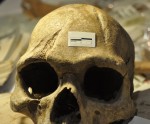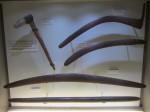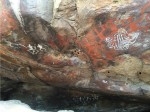 A man found buried in Toorale National Park in New South Wales, southeastern Australia, may be the first known boomerang victim. The skeletal remains were discovered on the bank of the Darling River during a 2014 archaeological survey. Erosion had exposed the cranium but the subsequent excavation found an almost complete skeleton in an excellent state of preservation. He was buried on his right side in a tightly flexed position facing upstream to the northwest, a careful, deliberate positioning that indicates he was respectfully buried by his people. Members of the Kurnu Baakantji Aboriginal group who inhabit the area dubbed him Kaakutja, meaning “Older Brother.”
A man found buried in Toorale National Park in New South Wales, southeastern Australia, may be the first known boomerang victim. The skeletal remains were discovered on the bank of the Darling River during a 2014 archaeological survey. Erosion had exposed the cranium but the subsequent excavation found an almost complete skeleton in an excellent state of preservation. He was buried on his right side in a tightly flexed position facing upstream to the northwest, a careful, deliberate positioning that indicates he was respectfully buried by his people. Members of the Kurnu Baakantji Aboriginal group who inhabit the area dubbed him Kaakutja, meaning “Older Brother.”
 Osteological analysis found that the deceased was an adult male between 25 and 25 years old at time of death. He was about 5’5″-5’7″ tall. There is evidence of sharp-force trauma in several places on his skeleton: two ante-mortem wounds on the cranium and peri-mortem trauma on the right side of the frontal bone, the cheekbone, maxilla, mandible, upper right humerus and five left ribs. He was hacked up, basically. Nothing like this pattern of trauma has been found on archaeological skeletal remains in Australia. Usually the injuries found are depression and parrying fractures. Only one other skeleton has been found with wounds inflicted by a sharp object and they were spear wounds. These are cutting
Osteological analysis found that the deceased was an adult male between 25 and 25 years old at time of death. He was about 5’5″-5’7″ tall. There is evidence of sharp-force trauma in several places on his skeleton: two ante-mortem wounds on the cranium and peri-mortem trauma on the right side of the frontal bone, the cheekbone, maxilla, mandible, upper right humerus and five left ribs. He was hacked up, basically. Nothing like this pattern of trauma has been found on archaeological skeletal remains in Australia. Usually the injuries found are depression and parrying fractures. Only one other skeleton has been found with wounds inflicted by a sharp object and they were spear wounds. These are cutting
Given the sharp-force trauma found on Kaakutja’s skeleton, archaeologists expected to find the remains dated to after the arrival of the English in the 18th century, but radiocarbon dating of the bone and one of the teeth, confirmed with optical dating of sediment inside the cranium, found that Kaakutja lived between 1220 and 1280, 500 years before James Cook set foot on the continent, and 600 years before English colonists settled New South Wales.
![]() Since the wounds could not have been caused by a metal blade, archaeologists turned to traditional Aboriginal weapons to explain Kaakutja’s injuries. One possibility is the lil-lil, a club-like weapon with a flattened, finely edged head. Another is the wonna, or fighting boomerang. This weapon is not the hunting boomerang, a curved throwing stick hurled at high speeds to take down prey, nor the returning boomerang which is what most people think of when they hear the word but is only a few hundred years old. The fighting boomerang was described by ethnographer R.H. Mathews in 1907 as “considerably bigger and heavier” than the returning boomerang with “a more open curve. It reminds one of the blade of a sabre and its inner edge is sharp and dangerous.”
Since the wounds could not have been caused by a metal blade, archaeologists turned to traditional Aboriginal weapons to explain Kaakutja’s injuries. One possibility is the lil-lil, a club-like weapon with a flattened, finely edged head. Another is the wonna, or fighting boomerang. This weapon is not the hunting boomerang, a curved throwing stick hurled at high speeds to take down prey, nor the returning boomerang which is what most people think of when they hear the word but is only a few hundred years old. The fighting boomerang was described by ethnographer R.H. Mathews in 1907 as “considerably bigger and heavier” than the returning boomerang with “a more open curve. It reminds one of the blade of a sabre and its inner edge is sharp and dangerous.”
 The wound going down Kaakutja’s face is probably too large to have been inflicted by a lil-lil. Boomerangs, on the other hand, could be as long as 18 inches and could certainly have caused his head wound. Archaeologists believe that was the first blow struck in the attack. Kaakutja’s was slashed with the fighting boomerang, likely taking out his eye. Then he was struck in the ribs, breaking five of them and probably bringing him to his knees. Then he was slashed across the top of the arm, carving off a circle of bone from the top of the humerus.
The wound going down Kaakutja’s face is probably too large to have been inflicted by a lil-lil. Boomerangs, on the other hand, could be as long as 18 inches and could certainly have caused his head wound. Archaeologists believe that was the first blow struck in the attack. Kaakutja’s was slashed with the fighting boomerang, likely taking out his eye. Then he was struck in the ribs, breaking five of them and probably bringing him to his knees. Then he was slashed across the top of the arm, carving off a circle of bone from the top of the humerus.
Kaakutja’s wounds suggest “close-range injuries—possibly hand-to-hand combat,” agrees Jo McDonald of the University of Western Australia, who was not involved with the study. Kaakutja’s forearms show no injuries from warding off blows. So Westaway and his colleagues speculate he was attacked with a boomerang designed to whip around the edge of a shield. Both shields and boomerangs were common items across the continent.
 Rock art at Gundabooka National Park, 15 miles east of the burial site, records ancient intertribal wars. The two sides are depicted in two different colors — orange and white ochre — and the fighters carry shields, clubs and very recognizable boomerangs. Perhaps Kaakutja met his end in just such a conflict.
Rock art at Gundabooka National Park, 15 miles east of the burial site, records ancient intertribal wars. The two sides are depicted in two different colors — orange and white ochre — and the fighters carry shields, clubs and very recognizable boomerangs. Perhaps Kaakutja met his end in just such a conflict.
The significance of the find is hard to overstate. Kaakutja’s wounds are unique in the pre-European Australian archaeological record. They suggest that traditional Aboriginal sharpened hardwood weapons of could cut bone much like metal blades can. It will also help archaeologists going forward in identifying the kind of wounds caused by Aboriginal weaponry.
Kaakutja’s remains have been reburied in a traditional Kurnu Baakantji ceremony, but the study of this unique individual and his violent end will continue. Next on the agenda is attempting to duplicate the wounds using replica weapons. The study of Kaakutja and his injuries has been published in this month’s issue of the journal Antiquity
The two ante-mortem wounds on his cranium might explain why it took additional effort to finish off poor Kaakutja. A fighting boomerang with an axe mounted onto it is known to us as ‘francisca’, and as it reads:
“Now the iron head of this weapon was thick and exceedingly sharp on both sides while the wooden handle was very short. And they are accustomed always to throw these axes and thus shatter the shields of the enemy and kill the men.”
Paragraph starting:
The significance of….
Should be….sharpened hardwood weapons could cut
Osteological analysis found that the deceased was an adult male between 25 and 25 years old at time of death.
? Does that mean he was 25?
@RMW: haha, I noticed that too 😀 Now it’s just a matter of figuring out how many months he was into his 25th year!
If the Abos hadn’t been good at killing people Australia would have been settled by Polynesians.
@ A -Maybe 25 weeks into his 25th year? (snicker) 🙂
That’s unknown to most archaeologists as the year was not generated in their studies. Although that is what the information suggests, it is likely that it was his accurate age.